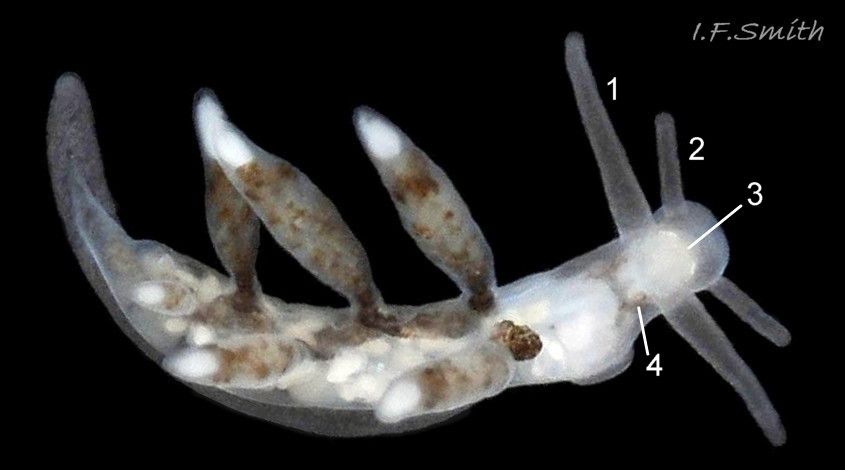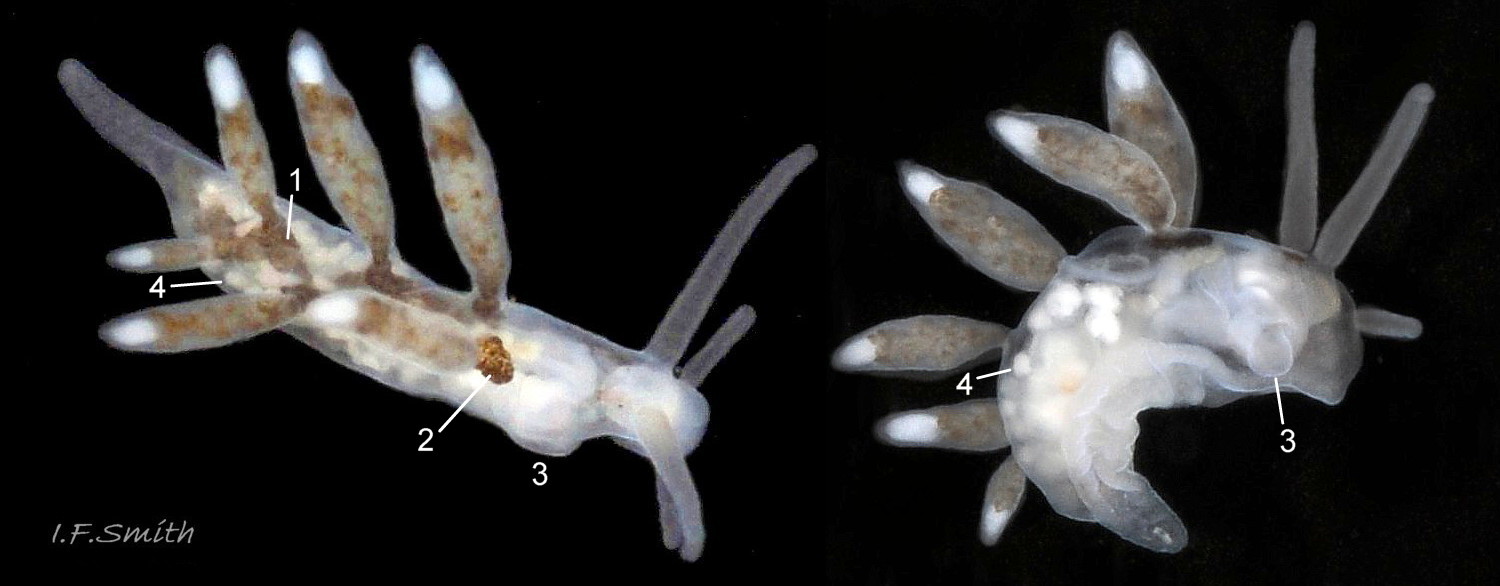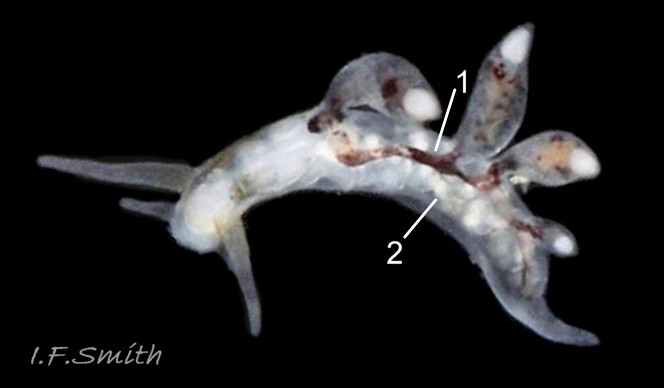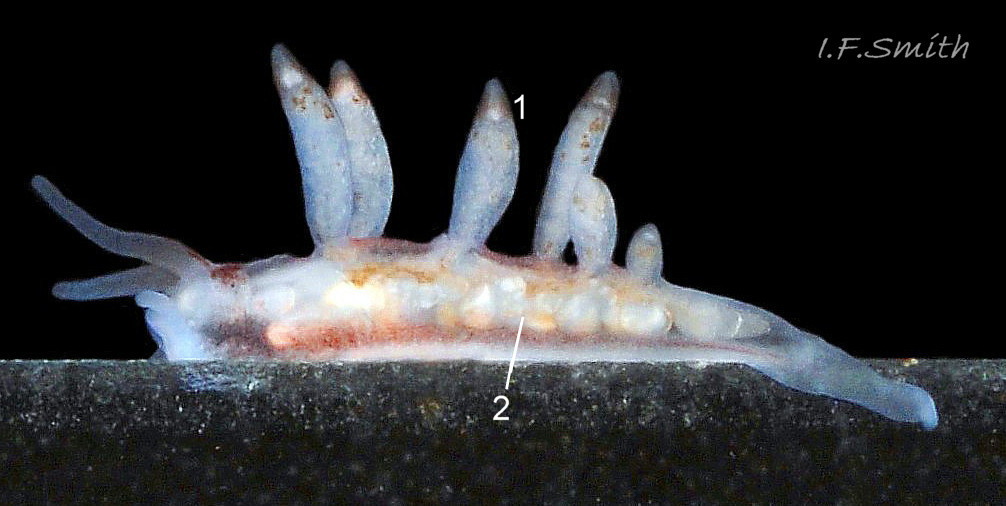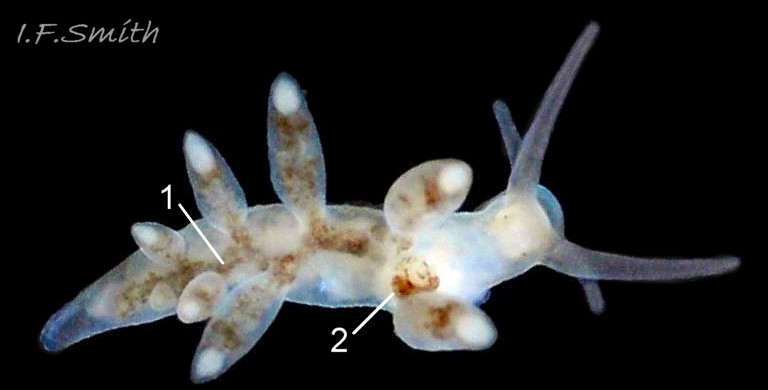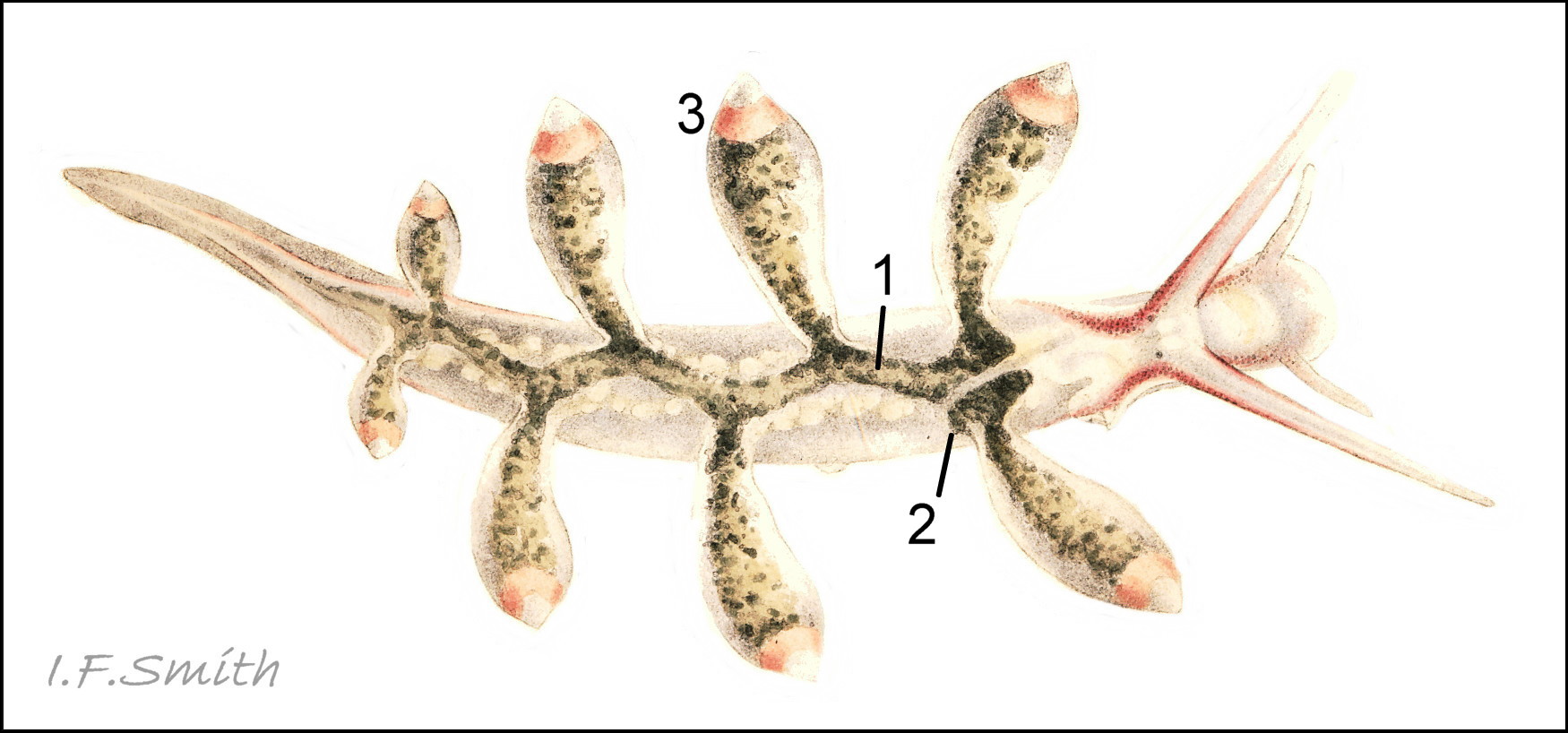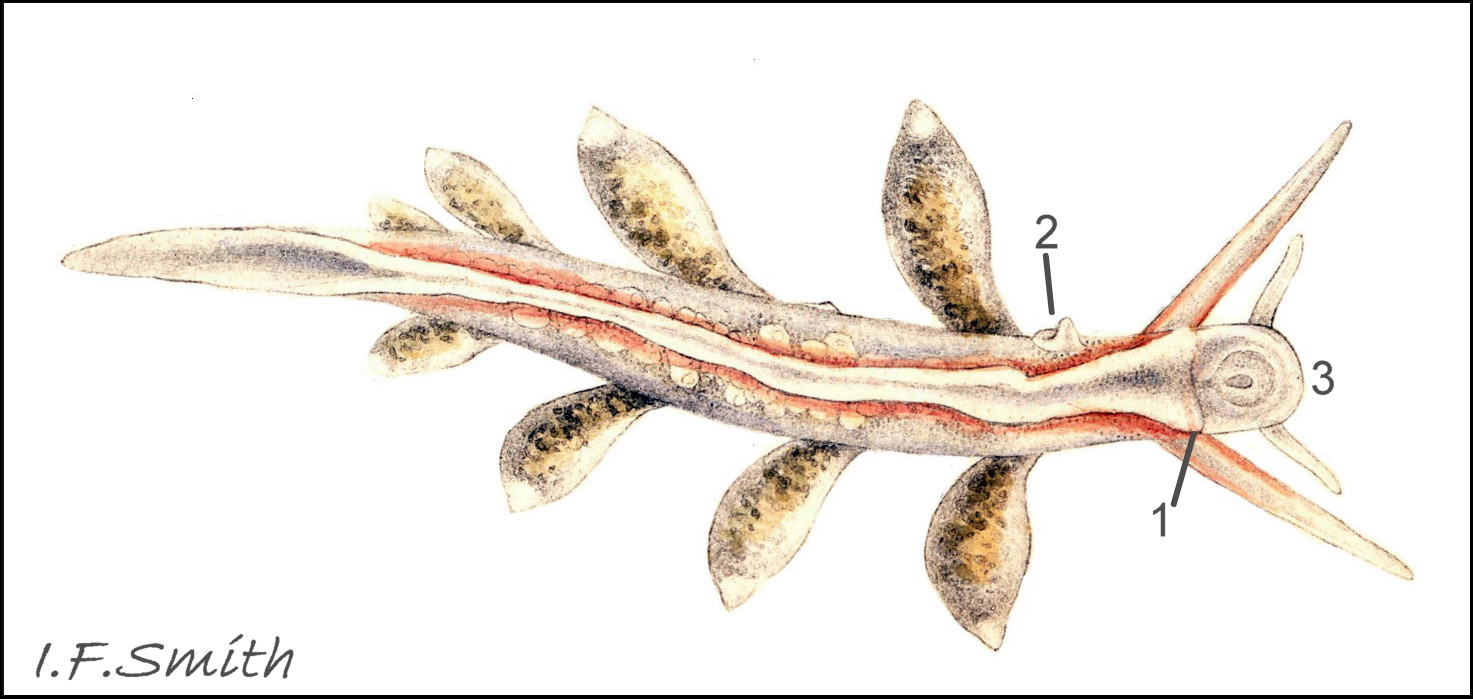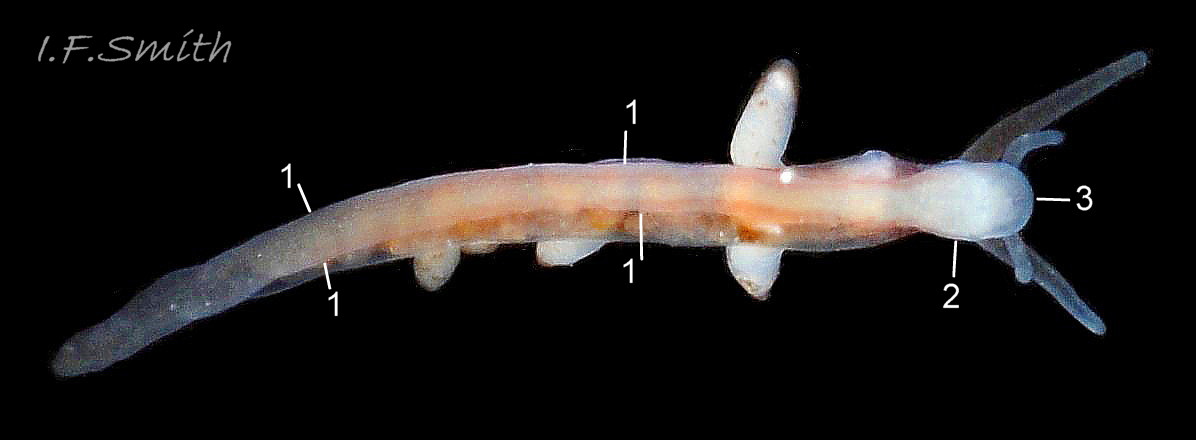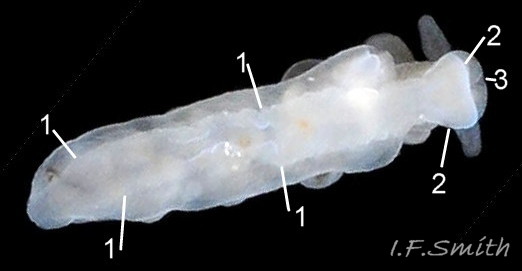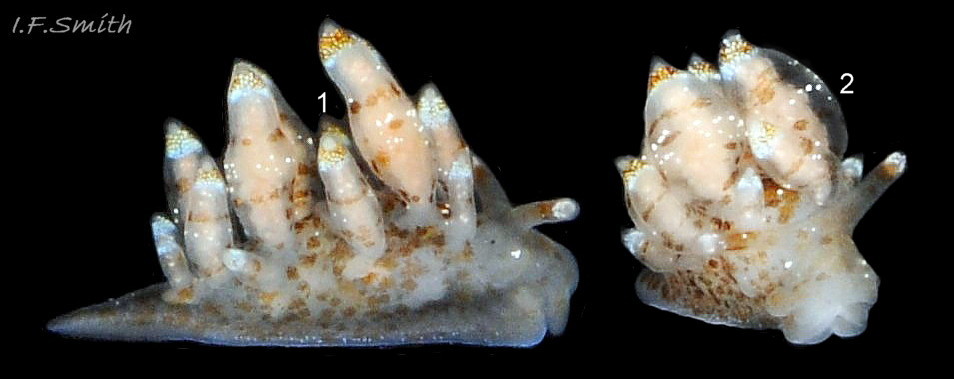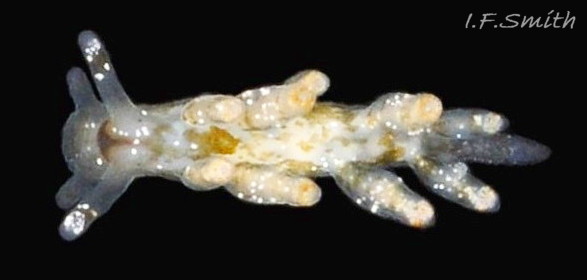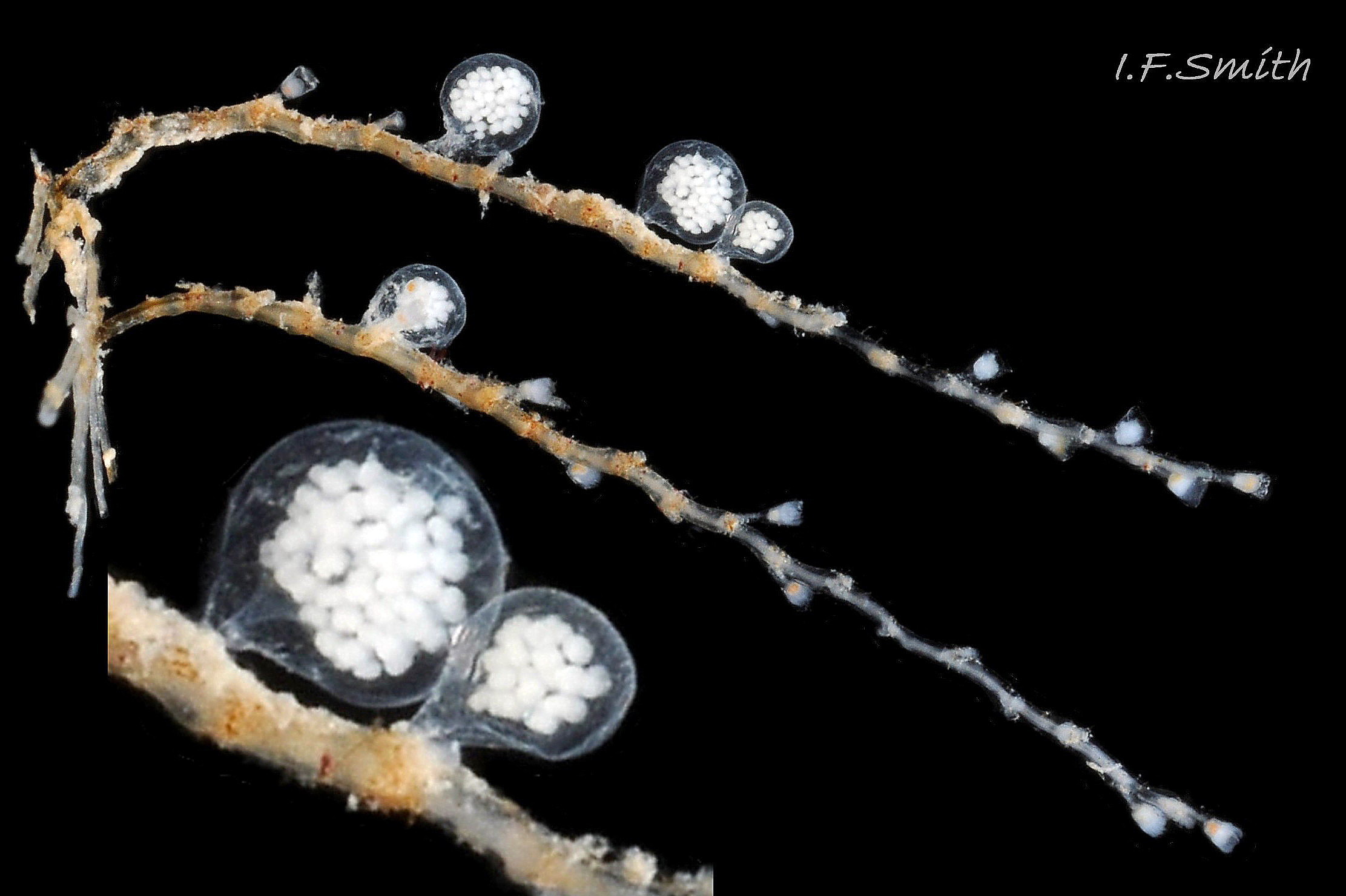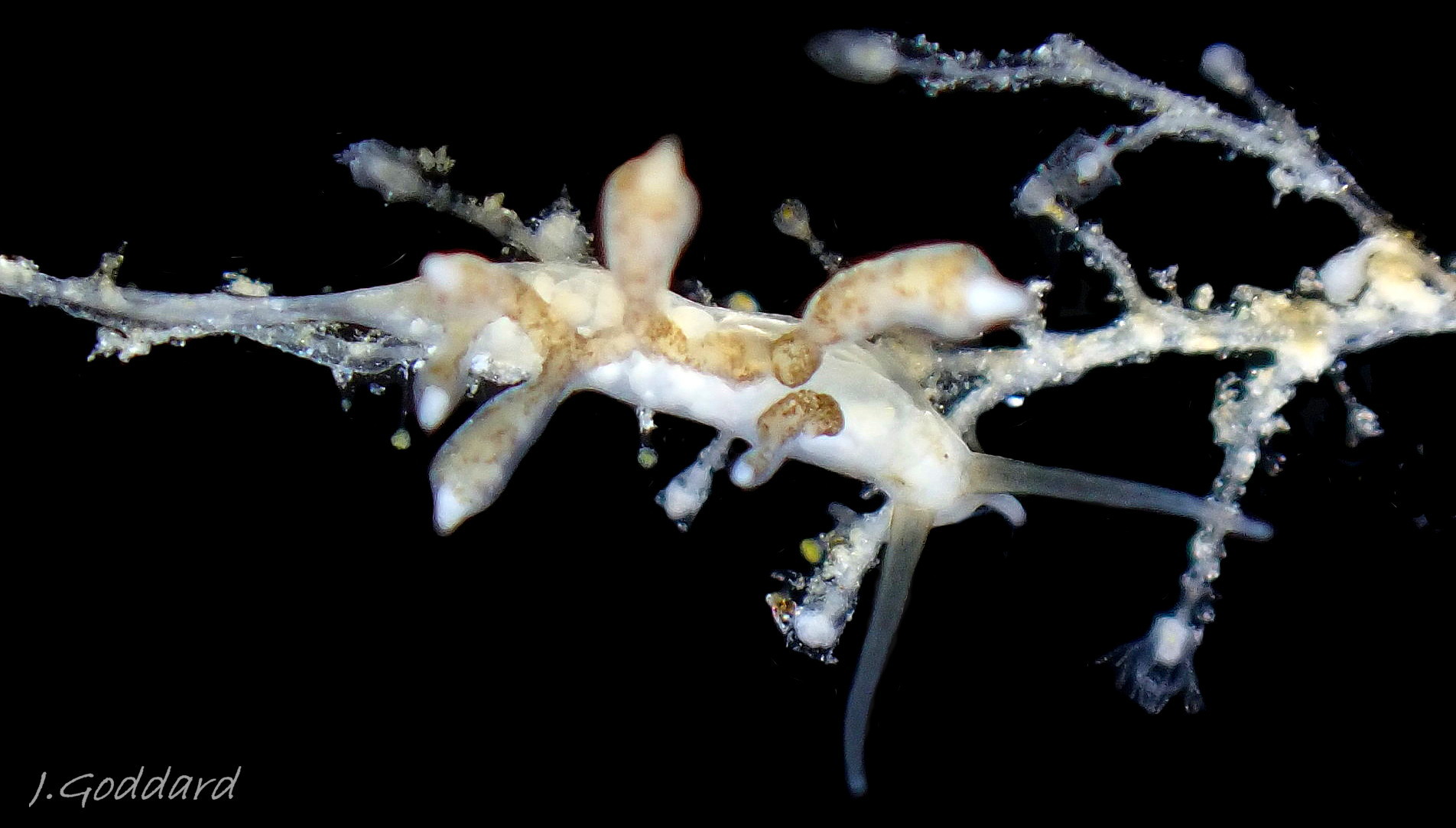Click image to enlarge with full caption. Main text below slider.
Tergipes tergipes (Forsskål, 1775).
PDF available at www.researchgate.net/publication/363263470_Tergipes_tergi…
Current taxonomy;
World Register of Marine Species www.marinespecies.org/aphia.php?p=taxdetails&id=141641
Synonyms: Limax tergipes Forsskål, 1775; Eolidia despecta G. Johnston, 1835.
GLOSSARY BELOW
Description
Tergipes tergipes is a minute species up to 7 mm, rarely 8 mm, long when fully grown; most finds are 5 mm or less. Differences from its larger relatives in arrangement of the digestive gland and cerata, and the disproportionately large cerata and genital opening, probably relate to its small size. The body is translucent white revealing white viscera such as the buccal mass, circum-oesophageal nerve ring with internal black eyes 01 Tergipes tergipes and, when adult, spheroid ovotestes 02 Tergipes tergipes & 05 Tergipes tergipes . The left digestive gland is often clearly visible as a brown or greenish dorsal zigzag band 02 Tergipes tergipes & 03 Tergipes tergipes but it may be faint 04 Tergipes tergipes . A disproportionately large hermaphrodite genital opening protrudes from the right side behind the rhinophore 02 Tergipes tergipes & 09 Tergipes tergipes (many publications replicate the unintended mirror image in Alder & Hancock showing it on the left, despite their note about the error). Some specimens have reddish brown staining on the rhinophores extending forwards onto the oral tentacles and backwards to the first ceras, and along the flanks below the cerata 04 Tergipes tergipes & 05 Tergipes tergipes , but on many it is faint or absent.
There are up to four, rarely five, single, relatively large cerata on each side of the body 02 Tergipes tergipes & 06 Tergipes tergipes . The first ceras on each side is opposite the other; the rest alternate in position. The short, brown, right digestive gland goes only to the first ceras on the right. The left digestive gland goes to the first and second cerata on the left and then zigzags left and right to cerata on either side 06 Tergipes tergipes & 07 Tergipes tergipes . The cerata are translucent white revealing the pale brown or greenish digestive gland granulated with a darker shade if recently fed. The transparent apex of each ceras contains a relatively large, opaque white cnidosac 08 Tergipes tergipes which is obscured on some specimens by a ring of reddish brown pigment 05 Tergipes tergipes & 07 Tergipes tergipes .
The smooth, tapering, translucent rhinophores are white faintly tinted brownish 01 Tergipes tergipes and sometimes with reddish brown pigment lines 05 Tergipes tergipes & 07 Tergipes tergipes . They are twice as long as the oral tentacles and usually held spread wide.
Dorsally, the front margin of the head is rounded with the bases of the translucent white oral tentacles set back from edge 01 Tergipes tergipes , and the opaque white buccal mass is visible through the almost transparent flesh. Ventrally, the head has a circular mouth with a small cleft in the lips 09 Tergipes tergipes , 10 Tergipes tergipes & 11 Tergipes tergipes . The translucent white foot is much narrower than the body. It is broadest at its anterior edge from which it narrows rapidly to form a triangular propodium.
Key identification features
Tergipes tergipes
1) Smooth slender cerata arranged singly 02 Tergipes tergipes .
2) Brown digestive gland zigzags between cerata 06 Tergipes tergipes .
3) Small, usually 5 mm or less long, rarely 8 mm.
Similar species
Eubranchus exiguus (Alder & Hancock, 1848)
1) Urn shape cerata able to expand balloon-like 12 Tergipes tergipes arranged in groups of 1-3.
2) Olive or brown blotches on body; no zigzag digestive gland 13 Tergipes tergipes.
3) Similar size to T. tergipes; frequently 4 – 6 mm long.
Often occurs in company with T. tergipes, but usually less numerous. Spawn masses are very similar so, although a good indication of presence of the species, not a reliable way to differentiate them in absence of adults.
Habits and ecology
T. tergipes lives on the lower shore and sublittorally to 20 m. It is found on hydroids, especially Obelia dichotoma growing on stones and O. geniculata on Laminaria fronds, and on many other hydroids on piers, floating structures and ships; even on isolated small stones in pools on mud. Its zigzag digestive gland resembles the stems and stolons of O. geniculata. It favours shores with moderate wave exposure or shelter, including estuaries down to 10‰ salinity 14 Tergipes tergipes .
It is a simultaneous hermaphrodite and can reach maturity and develop spheroid ovotestes when 2.5 mm long 03 Tergipes tergipes . Spherical or kidney-shape transparent spawn masses 15 Tergipes tergipes , each containing up to about a hundred white ova, are produced throughout the year. Spawn masses on hydroid are easier to detect, and much more numerous, than adults 16 Tergipes tergipes . After hatching, the short veliger stage lasts about a week before metamorphosis. Individuals mature in five weeks, with the ovotestes developed in 2.5 mm long specimens, so there are many generations each year.
Distribution and status
T. tergipes occupies Atlantic coasts from Iceland and Norway to eastern U.S.A. (Cámara et al., 2014) 17 Tergipes tergipes and to Spain, and the Mediterranean. GBIF map www.gbif.org/species/2292363 .
It is common all round Britain and Ireland, but overlooked as its small size requires inspection of hydroids under magnification. Over 100 were found on the hydroids on a single Laminaria frond (IFS, June, 1976, Orkney) and densities of 500 /m² have been recorded (Swennen, 1959, Netherlands, in Thompson & Brown 1984). NBN UK map species.nbnatlas.org/species/NHMSYS0021056159 .
Acknowledgements
For use of an image I thank Jeff Goddard.
References and links
Alder, J. & Hancock, A. 1845-1855. A monograph of the British nudibranchiate mollusca. London, Ray Society. Fam. 3 Pl. 36. www.biodiversitylibrary.org/item/131598#page/432/mode/1up
Cámara, S., Carmona, L., Cella, K., Ekimova, I., Martynov, A. and Cervera, J.L. 2014. Tergipes tergipes (Forsskål, 1775) (Gastropoda: Nudibranchia) is an amphiatlantic species. J. Mollus. Stud. 80(5): 642-646. academic.oup.com/mollus/article/80/5/642/1035173
Swennen, C. 1959. The Netherlands coastal waters as an environment for Nudibranchia. Basteria 23: 56-62.
Thompson, T.E. & Brown, G.H. 1984. Biology of opisthobranch molluscs 2. London, Ray Society.
Glossary
cerata = (sing. ceras) lobes on dorsum of Fionoidea and some other seaslugs.
circum-oesophageal nerve ring = ganglia-bearing nerve cord (the ‘brain’) which encircles the oesophagus in gastropods.
cnidocytes = explosive stinging cells of Cnidaria. en.wikipedia.org/wiki/Cnidocyte
cnidosac = storage capsule at tips of cerata of Fionoidea for ingested unexploded cnidocytes.
digestive gland = organ in gastropods which acts like liver and pancreas in mammals to absorb food.
ganglia = (sing. ganglion) knots containing sensory cell bodies on a nerve cord, which conducts impulses to innervate organs of the body.
LWST = low water spring tide; two periods of a few days each month when tide falls lowest.
oesophagus = tube from mouth to stomach.
ovotestis = (pl. ovotestes) hermaphrodite organ serving as both ovary and testis.
propodium = anterior portion of gastropod foot. (adj. propodial).
rhinophores = chemo-receptor tentacles on top of head of nudibranch.
stolon = stemlike runner of colonial hydroids attaching the colony to the substrate.
veliger = shelled larva of marine gastropod or bivalve mollusc which moves by action of cilia on a velum (bilobed flap). Stage may be passed in plankton or within liquid-filled egg-capsule.
